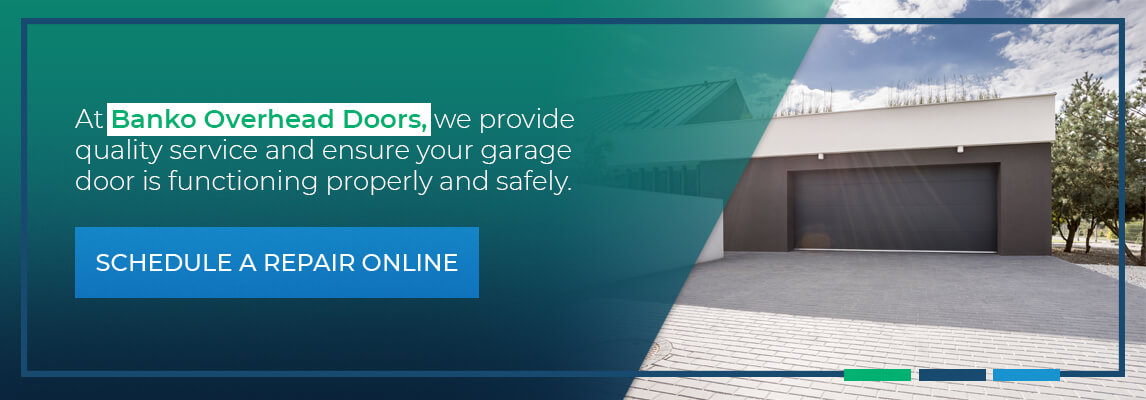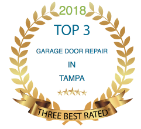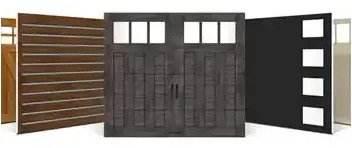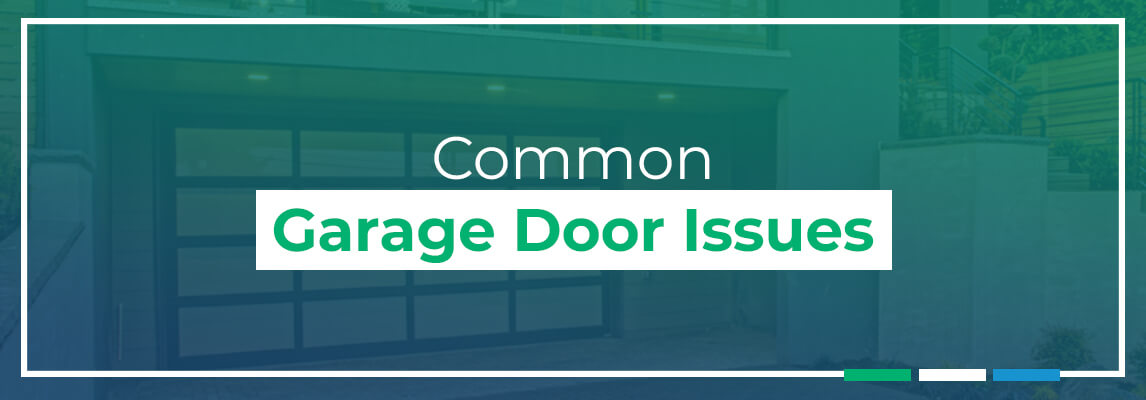
As garage door professionals, we’ve come across just about every issue you can imagine. But usually, garage door problems are caused by a handful of issues that we see frequently. Here are the top reasons your garage door might not be working, plus a solution for what you can do about it!
Your garage door is likely the most prominent moving part of your house, and you probably use it every day. Because of this, parts can wear or break over time and create a potential safety hazard.
While you want to perform monthly maintenance and signs-of-danger checks of your whole garage system, scheduling a yearly visit from a professional garage door system technician will keep your garage door operating smoothly and safely for a long time. And this can help prevent serious injuries.
The best thing you can do for your garage door is to pay attention to it. While it may seem like a simple mechanism without much oversight required, this isn’t always true. Pay attention to the cables, hardware, tracks — and even small things like weather stripping. If you notice any changes or see any potential issue, call in a professional to visit to take a look.
Table of Contents
- Garage Door Injuries
- 21 Common Garage Door Issues
- How to Prevent Common Garage Door Issues
- An Important Garage Door Safety Notice
- Contact Banko Overhead Doors for Your Garage Door Maintenance and Repairs
Garage Door Injuries
Each year, around 30,000 injuries occur due to garage door issues, according to the U.S. Consumer Product Safety Commission. Even more troubling about these statistics is many garage door-related injuries involve children.
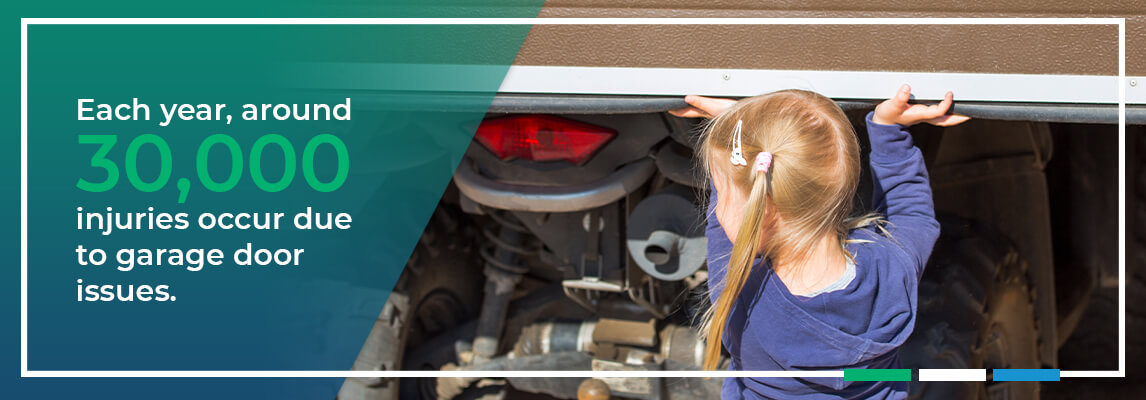
Although your garage door might seem simplistic and not harmful, unfortunately, this isn’t always the case. The National Electronic Injury Surveillance System (NEISS), who has been involved in regulation for safe garage door standards going back to the 90s, compiles statistics on injuries involving both electronic and manual garage doors. The organization reveals common problems with garage doors can lead to potentially serious and dangerous physical harm. They also highlight how important it is to have professional help with your garage door maintenance — and not try to do any repairs yourself.
And if the professional recommends you get a new garage door, don’t skimp out on this as it could save you from a potential injury. According to Remodeling magazine’s Cost Versus Value report, you recoup 98 percent of the average garage door costs value at resale.
21 Common Garage Door Issues
Below we highlight 21 of the most common garage door problems:
1. Broken Springs
If your garage door is opening unevenly or if it’s making weird screeching, creaking or popping noises, it’s likely a sign of faulty or broken garage door springs. Most garage doors weight between 125 to 250 pounds, and without working springs, your garage door opener can’t lift the door.
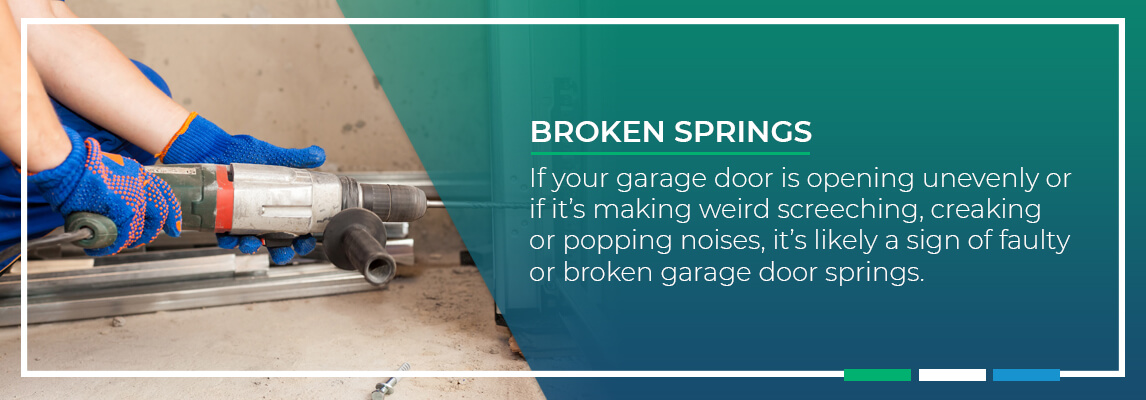
What to do: You should never attempt to replace broken springs yourself. Because springs are under high tension, only a qualified professional should adjust them to prevent injuries. Besides, newer garage door models have tamper-resistant brackets to prevent the inexperienced but adventurous among us from getting into trouble.
Further, if you have an older garage door, be sure a professional inspects the garage door springs and replaces them if necessary.
Your garage door extension and torsion springs should be replaced on average every three to five years, or 10,000 cycles. Aside from having them routinely inspected professionally, you should also oil the springs with a lubricant, like WD-40, every season in order keep them rust-free and moving freely.
2. Malfunctioning Photo Eye (Sensor)
Many of the garage doors built within the past couple of decades or so come with a safety photo eye feature to detect if an object or person is blocking the door and keeping it from completely lowering. The sensor has a laser shooting across the length of the garage and when something interrupts it, it cuts the signal that lowers the door and causes the door to raise back up. If this happens, you’ll want to get this problem corrected as soon as possible, as it’s a critical safety feature.
What to do: You’ll first want to check the cord attached to the eye and see if it’s damaged or cut; a leak or rainstorm could cause damage to the photo eye. Dust, dirt, cobwebs or other objects can also clog the eye, blocking the laser. In these cases, sometimes all it takes is a good cleaning using a tissue to solve the problem.
For most garage doors, the photo-eye is around four to six inches off the ground with a pea-sized eye. If it’s installed above six inches, it’s possible a small child or animal could get trapped below the photo eye’s pathway.
3. Malfunctioning Remote Control
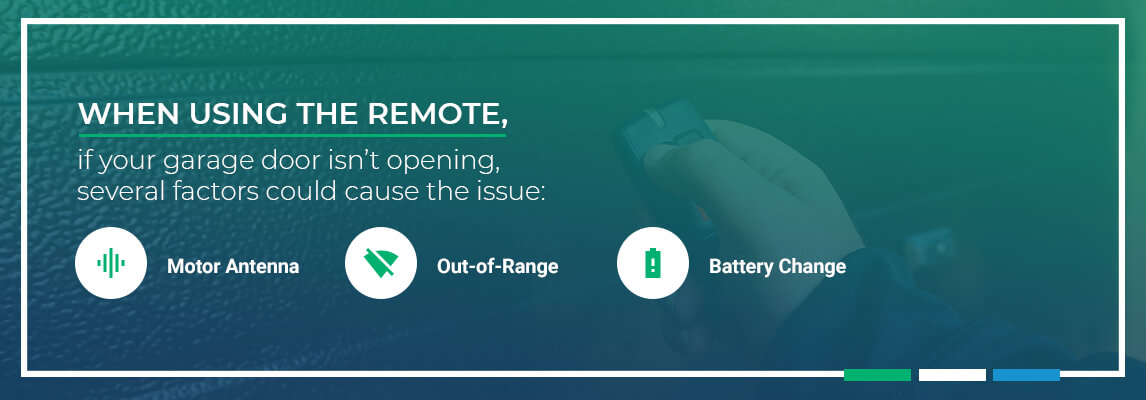
When using the remote, if your garage door isn’t opening, several factors could cause the issue:
- The motor antenna has damage or something is blocking the signal — ensure the antenna is hanging down from the motor.
- You could be out-of-range.
- You may need a battery change if you can open the door from the wall switch.
What to do: If none of these seem the cause of the problem, you may have to reprogram the remote. Check your manual for instructions to reprogram your remote or call a garage door expert to walk you through how to do this.
4. The Sensitivity Is Out of Adjustment
Both older and newly installed garage doors can have this problem. When the sensitivity is set too high or low, the door doesn’t open.
What to do: You’ll need the sensitivity reset. The limit switch and close force should be readjusted to the proper levels. Your manual may explain how to perform this sensitivity reset, or you can call your local garage door maintenance professional.
5. Dead Transmitter Batteries
To work, your garage door transmitters require power. If you have dead transmitter batteries, the transmitter can’t send the garage door a signal to open.
What to do: You’ll first want to ensure the transmitter on your garage wall will still open the door when pressed. If it does still open the door, you may need a new battery in the transmitter inside your car. Check all transmitters to see if they require batteries since chances are, they were all likely installed the same day.
Changing a battery on the transmitter is fairly simple. Typically, you slide open the transmitter door and take out the battery. Some may require you to screw the door open and closed to secure the battery inside.
Ensure you install the new batteries in correctly, lining up the plus and minus signs. If the transmitter still doesn’t open the door after you install a new battery, check to see if you lined up the plus and minus signs correctly. Once you put in the new battery, the transmitter should work again.
6. Transmitter Isn’t Working Properly
Several things could be keeping the transmitters from working properly.
- The transmitter is not within range. A typical reason is the transmitter is not within the range of your garage door. Each transmitter and garage door combo has a certain range, and when you’re not within it, it doesn’t work. So, if you try opening your garage door before you even get down your street, chances are you’ll be out of range, and it won’t work. Wait until you drive into your driveway or at least see your house before you press the transmitter.
- The antenna is blocked. Now, if you are in range and you still can’t get the door to open, ensure the antenna inside your garage is hanging down from the motor, and nothing is blocking it. The antenna needs to be free of all blockages or obstructions for it to receive the signal clearly to open and close the garage door. You’ll also want to check for any damage to the antenna. If you notice any damage, give your garage door professional a call to come and replace it with a new one.
- The transmitter button is stuck. If your door is randomly opening and closing without you pressing the button, first you’ll want to see if it’s a simpler problem. For instance, ensure the transmitter isn’t caught up on something that’s pressing the button. It could be wedged in between the car window and visor or stuck between the seat and console of your car.
- The frequency is off. If nothing is pressing up on the button, you might want to check the frequency of the transmitter. Your neighbors could be running off the same frequency as your garage door, and when they press their transmitter, it opens your garage door along with theirs. If this is the case, a garage door expert can help change the frequency, so this doesn’t continue to happen. You may even find the instructions in the manual.
What to do: You may have to reprogram your transmitter if you’ve checked for all these issues and it wasn’t the problem. Look for the “learn” button on the transmitter and press and hold it down for several seconds until you get a blinking indicator light. Once the light begins to blink, press the remote button again which will then reprogram your remote.
While this may seem like a simple process, each garage door model is different. Therefore, you’ll want to look over the owner’s manual to get the specific instructions for your model. Reprogramming the remote shouldn’t take more than a few steps.
7. Limit Setting Requires Adjustment
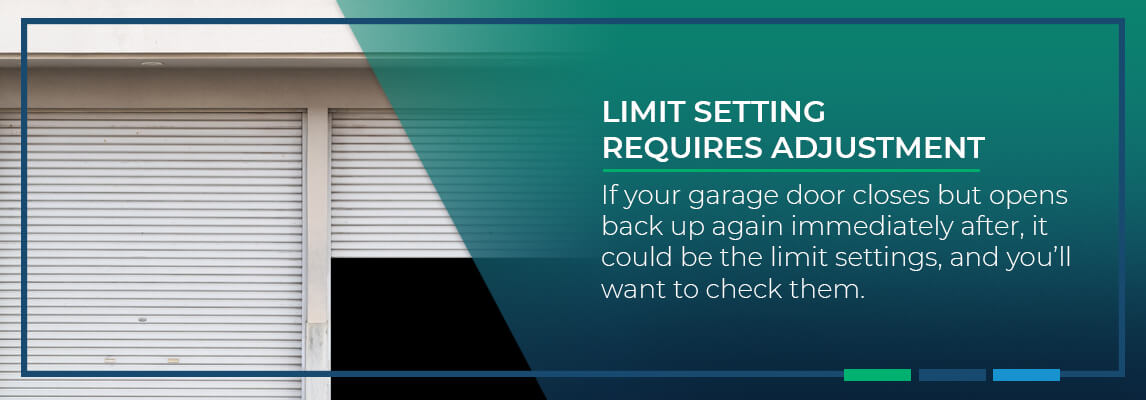
If your garage door closes but opens back up again immediately after, it could be the limit settings, and you’ll want to check them. If the settings are switched to off, when your garage door hits the ground, the opener will think it’s not supposed to yet, assume it hit an obstacle and to avoid damage it will backtrack automatically. There should also be instructions in the owner’s manual on the limit settings and how to adjust them correctly.
What to do: Many models have an “up” and “down” label — check your manual. You’ll want to adjust the limit setting to “down” if your door isn’t closing and “up” if it’s not opening. For most models, a complete turn of the screw is equivalent to around two door movement inches. Don’t overdo it, make small adjustments. Otherwise, you risk slamming your door shut or open. Continue testing small adjustments until you get it right.
8. Noisy Door
If the door on your garage is loud, chances are something is wrong with it. While it’s not uncommon for a garage door to make some noise when it opens and closes due to all the parts making it function, if you notice the noise getting louder, you may want to have a garage door professional take a look at it.
Generally, a loud garage door could indicate several things such as:
- The door needs lubrication.
- The door is off the track.
- The motor or opener is failing.
- The springs are starting to rust or age.
In many cases, a loud sound is a signal you’re about to have a problem with your garage door.
What to do: Get it inspected now when you hear the noise — rather than waiting for it to break down completely. It could save you a lot of money.
9. Blocked Door Path
If your door begins closing and all of a sudden it reverses and starts opening up, it could be due to a blockage of the door path on the ground. Some object, like a trash can or toys, could be blocking the door on its track.
What to do: Check and see if anything is blocking the track. Then check the track for any dust or dirt buildup. If it’s dirty, wipe it down with a damp rag or towel. Ensure the track is kept clean of debris to prevent this problem in the future.
10. Disconnect Switch is On
If the opener motor is running the entire time it would normally take to open or close your door, but your door isn’t moving, you could have accidentally enabled the disconnect switch. Every garage door opener comes with a disconnect switch for emergency purposes in case you lose power and you need to open or close the door manually.
This switch is usually attached to a knob you turn or a rope you pull. Sometimes, this rope could become unhooked accidentally from the switch. When this occurs, it disconnects the door from the motor.
What to do: You’ll want to open or close your door entirely and attach the rope again. Try using your transmitter or remote to open it back up again to see if it works now.
11. Misaligned or Warped Tracks
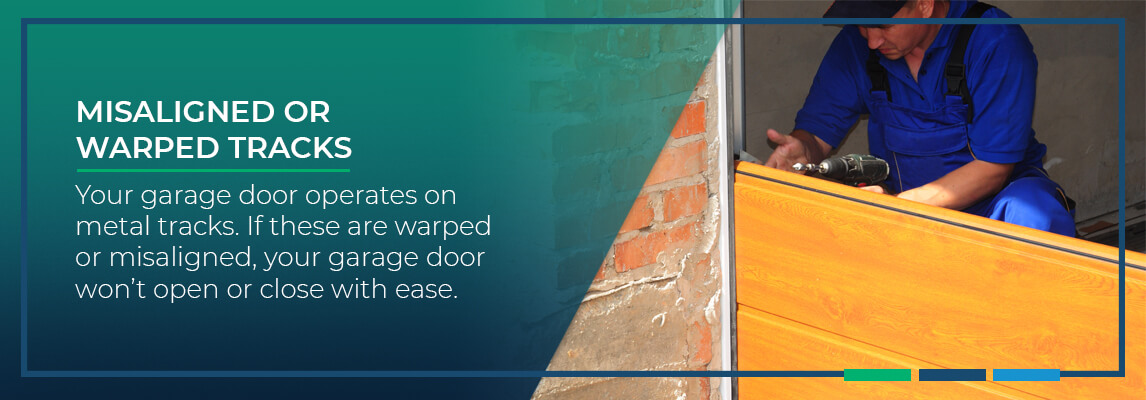
Your garage door operates on metal tracks. If these are warped or misaligned, your garage door won’t open or close with ease.
What to do: Contact a garage door professional who can either straighten the bend or replace the track altogether, depending on what’s required.
12. There Are Rust Spots on Garage Door Bottom
Rust spots on the bottom of your garage door could be due to salt or chemicals you used to melt snow and ice in the winter from your driveway. Rust compromises your garage door’s ability to fend off dirt.
What to do: Ensure you use soap and water to clean your garage door and remove any debris built-up on the exterior of the door. After cleaning, rub the rust with a vinegar-soaked cloth. A spring or fall maintenance checkup from a garage repair expert can help you prevent door rust.
13. Damaged Motor
A motor powers the cables of an automatic garage door to raise and lower the door. Similar to small engine motors, the motor of an automatic garage door can get worn out or become damaged over time, particularly if your building is dusty all the time.
What to do: Have a professional come in and replace the motor if needed.
14. Broken Cable
If a cable broke, your garage door might not open on one side. Or, if both cables are broken, your garage door won’t open at all, potentially locking you out. Fortunately, a garage door professional can easily replace a broken cable.
If the cables aren’t broken but appear visually frayed or worn, they’re at risk of breaking.
What to do: Due to the high tension associated with these cables, only a garage repair and installation specialist should perform the job.
15. Door Came off Its Hinges
Usually, this happens when the bolts have come unscrewed holding the brackets, the metal bracket at the end comes loose or the horizontal tracks have come out of alignment.
What to do: If your door has come off its hinges or has fallen on the floor completely, avoid being near it and get a garage door professional to come to repair it right away to avoid injury.
16. Weather Stripping Damage
To keep warm air in and cold air out, you likely have airtight rubber weather stripping on your garage door at the bottom. In the winter, water may sometimes freeze around the door base and trap this stripping between the ground and ice. When you attempt to open the door, it tears off the stripping.
And, as time goes on, the stripping gets older and starts to harden and crack, releasing the seal and reducing the warmth. Losing the seal on a large door like this can cause a significant increase in your heating bill.
What to do: Prevent these garage door issues by sweeping away the water and snow from the door base before it freezes. Regularly check the weather stripping to ensure it isn’t worn and causing loss of warmth.
17. Excess Grease
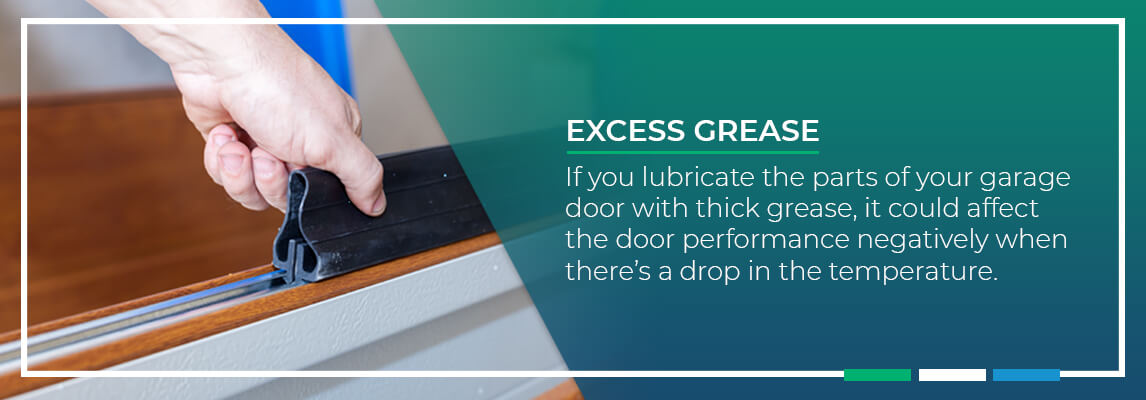
If you lubricate the parts of your garage door with thick grease, it could affect the door performance negatively when there’s a drop in the temperature.
What to do: You should remove the grease and apply a thin white lithium grease or silicone spray coat. While you should lubricate the moving parts of your garage door, avoid lubricating plastic parts.
18. Loose Tamper-Resistant Brackets
Since the garage door bottom brackets are attached to the springs of the door, the brackets are under a lot of tension and become loose over time.
What to do: Only a professional should loosen or adjust them. In most cases these days, manufacturers now include tamper-resistant hardware preventing the brackets from being loosened by inexperienced people.
19. It’s Locked
This is a simple but common issue.
What to do: If your door isn’t moving, but the motor is running, check to see if it’s manually locked. See if any metal parts have fallen down to bar access and if so, locate the locking handle or knob and disengage the lock.
20. Malfunctioning Garage Door Opener
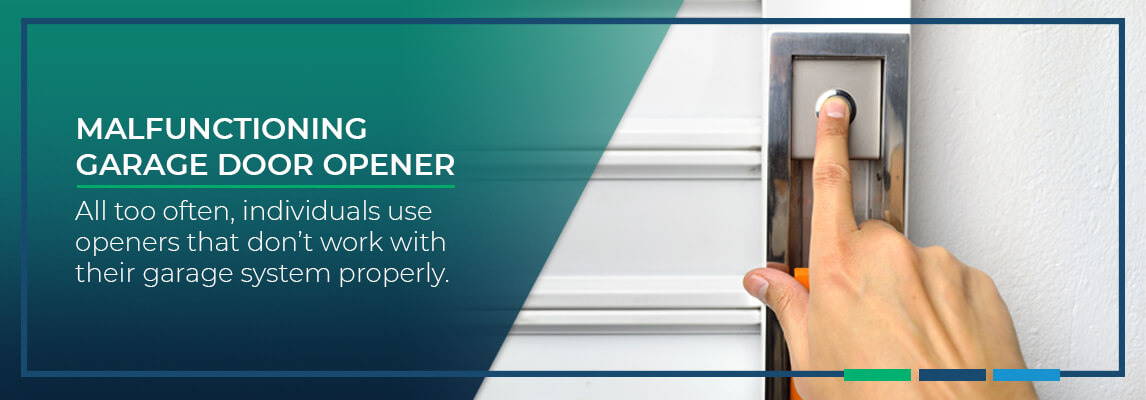
In many cases, the issues are with the garage door opener. All too often, individuals use openers that don’t work with their garage system properly.
What to do: Make sure you’re using a compatible garage door opener with your system.
On the other hand, all your garage door opener may need is a bit of lubricant to reduce friction. Apply silicone-based lubricant to the full length of the garage door opener, being sure to wipe off any excess. If these solutions don’t remedy the problem, call in a professional to investigate.
21. Electronic Keypad Is Malfunctioning
Due to moisture, debris or other environmental factors, keys on the garage door keyboard can become stuck or fixed.
What to do: Check to see if anything is contacting the buttons or surface areas of the keyboard. Clean the keyboard gently with soap and water. If this doesn’t do the trick, you may need to have the electronic keypad replaced by a garage door professional.
How to Prevent Common Garage Door Issues
A good way to avoid garage door problems is to have it serviced regularly by a professional. This is no different than having your pool or HVAC system serviced. Professionals recommend annual maintenance and servicing to check for any potential issues and keep your garage door functioning smoothly.
During the maintenance and service appointment, the expert will check its:
- Springs
- Lubrication
- Pulleys
- Rollers
- Hinges
- Bearings
They’ll also look for common garage door problems requiring repair. Whether or not you think your garage door needs servicing, good general maintenance is essential and one step towards better home security and preventing injuries.
An Important Garage Door Safety Notice
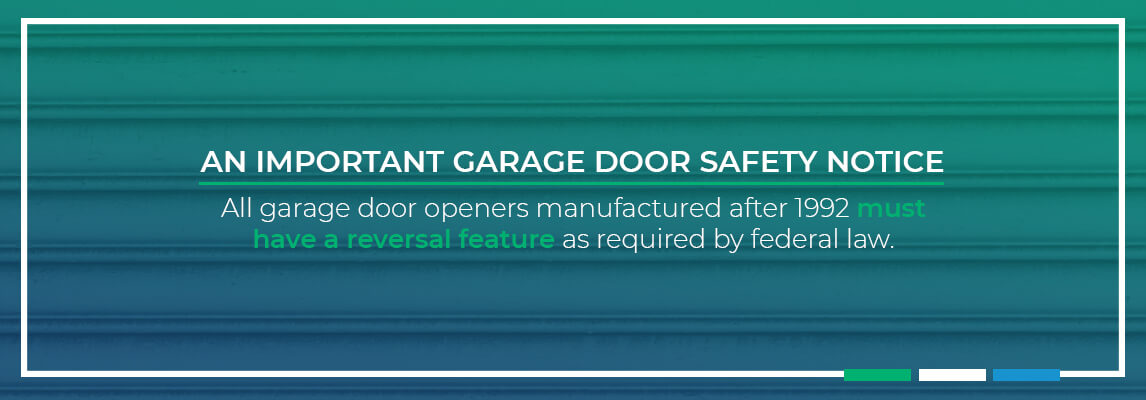
Your garage door opener should have a reversal feature. All garage door openers manufactured after 1992 must have a reversal feature as required by federal law. If yours doesn’t, you need to get it replaced.
If your garage door opener contains this safety feature, conduct a reversal test monthly. Place a small one and a half inch piece of wood directly under the door. If it doesn’t reverse after hitting the wood, contact your garage door professional to adjust, repair or replace the opener or door.
Contact Banko Overhead Doors for Your Garage Door Maintenance and Repairs
It bears repeating — it’s always a wise idea to hire a professional garage door repair or maintenance person to come in to get the job done. Never attempt the job yourself as it could cause injuries. Faulty or broken garage doors have come down on people, so you want to ensure you have regular maintenance and service appointments set up.
Typically, you don’t want to wait to call in a garage door expert. You’ll want them to check out the issue right away before it goes from just a simple annoyance of the door not opening properly to a potential injury or home security risk. Hiring a professional right away can ensure both your convenience and your safety no matter what the issue is.
At Banko Overhead Doors, we provide quality service and ensure your garage door is functioning properly and safely. Contact us to schedule your garage system maintenance or schedule a repair online. We have locations across southwest Florida and service the Tampa Bay area and surrounding communities including Manatee, Sarasota, Pinellas, Pasco and Hillsborough.
Additional Resources on Garage Door Repairs:
- What to Check When Your Garage Door Opens By Itself
- Why Did my Garage Door Come Off Its Tracks?
- 5 Reasons Your Garage Door Isn’t Working
- Garage Door Repair Scams

